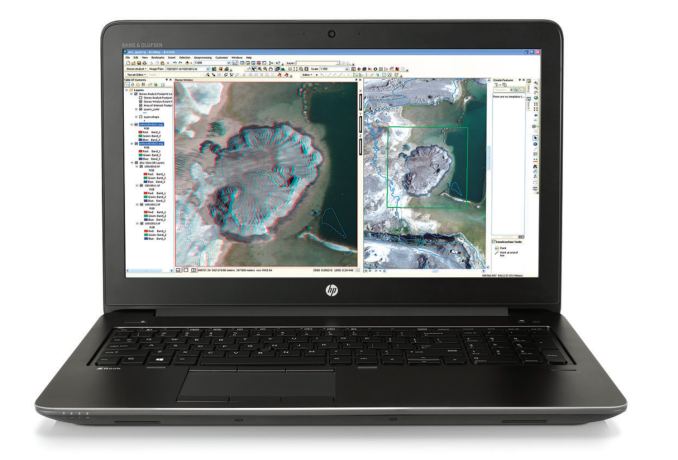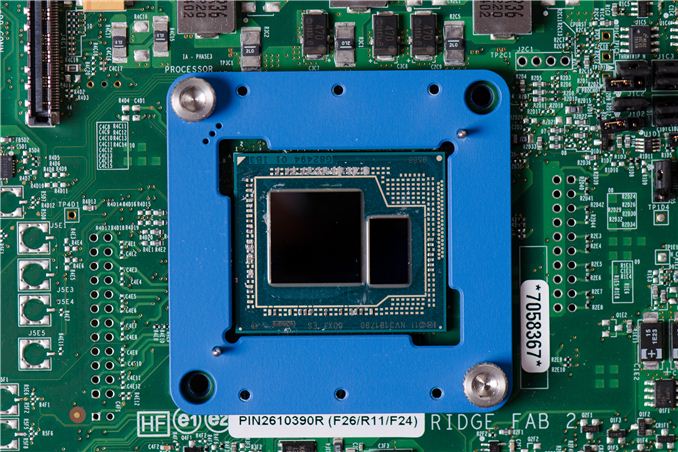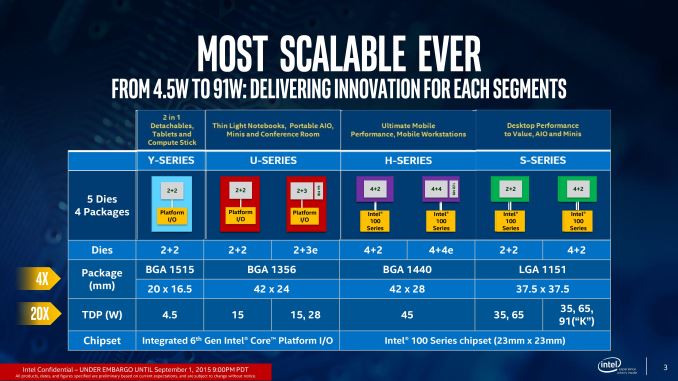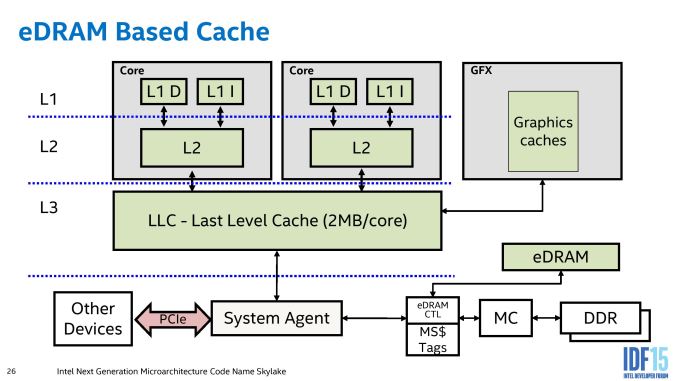Skylake Iris Pro hits Intel’s Pricing Lists: Xeon E3-1575M v5 with GT4e
by Ian Cutress on January 26, 2016 12:17 PM EST- Posted in
- CPUs
- Intel
- Mobile Workstation
- Xeon
- Mobile
- Laptops
- Enterprise
- Skylake
- eDRAM

One of our forum members, Sweepr, posted Intel’s latest pricing list for OEMs dated the 24th of January and it contained a number of interesting parts worth documenting. The Braswell parts and Skylake Celerons were disclosed over the past few months are now available to OEMs, but it’s the parts with Iris Pro that have our attention.
Iris Pro is Intel’s name for their high end graphics solution. Using their latest graphics microarchitecture, Gen9, Iris Pro packs in the most execution units (72) as well as a big scoop of eDRAM. At the minute we assume it’s the 128 MB edition as Intel’s roadmaps have stated a 4+4e part only on mobile, rather than a 4+3e part with 64 MB (only the 2+3e parts are listed as 64MB), although we are looking for confirmation.
The new parts are listed as:
Xeon E3-1575M v5 (8M cache, 4 Cores, 8 Threads, 3.00 GHz, 14nm) - $1,207
Xeon E3-1545M v5 (8M cache, 4 Cores, 8 Threads, 2.90 GHz, 14nm) - $679
Xeon E3-1515M v5 (8M cache, 4 Cores, 8 Threads, 2.80 GHz, 14nm) - $489
These will compare to the non-Iris Pro counterparts, running P530 graphics (4+2, 24 EUs):
Xeon E3-1535M v5 (8M cache, 4 Cores, 8 Threads, 2.90 GHz, 14nm) - $623
Xeon E3-1505M v5 (8M cache, 4 Cores, 8 Threads, 2.80 GHz, 14nm) - $434
As Sweepr points out, the difference between the 2.8-2.9 GHz parts is only $55-56. That is for both the increase in graphics EUs (24 to 72) as well as that extra on-package eDRAM.

The i7-4950HQ with 128 MB eDRAM
We have more reasons to be excited over the eDRAM in Skylake than what we saw before in Haswell with the i7-4950HQ on mobile and Broadwell on desktop with the i7-5775C, i5-5765C and the relevant Xeons. With the older platforms, the eDRAM was not a proper bidirectional cache per se. It was used as a victim cache, such that data that was spurned from the L3 cache on the CPU ended up in eDRAM, but the CPU could not place data from the DRAM into the eDRAM without using it first (prefetch prediction). This also meant that the eDRAM was invisible to any other devices on the system, and without specific hooks couldn’t be used by most software or peripherals.
With Skylake, this changes, the eDRAM lies beyond the L3 and the System Agent as a pathway to DRAM, meaning that any data that wants DRAM space will go through the eDRAM in search for it. Rather than acting as a pseudo-L4 cache, the eDRAM becomes a DRAM buffer and automatically transparent to any software (CPU or IGP) that requires DRAM access. As a result, other hardware that communicates through the system agent (such as PCIe devices or data from the chipset) and requires information in DRAM does not need to navigate through the L3 cache on the processor. Technically graphics workloads still need to circle around the system agent, perhaps drawing a little more power, but GPU drivers need not worry about the size of the eDRAM when it becomes buffer-esque and is accessed before the memory controller is adjusted into a higher power read request. The underlying message is that the eDRAM is now observed by all DRAM accesses, allowing it to be fully coherent and no need for it to be flushed to maintain that coherence. Also, for display engine tasks, it can bypass the L3 when required in a standard DRAM access scenario. While the purpose of the eDRAM is to be as seamless as possible, Intel is allowing some level on control at the driver level allowing textures larger than the L3 to reside only in eDRAM in order to prevent overwriting the data contained in the L3 and having to recache it for other workloads.
We go into more detail on the changes to Skylake’s eDRAM in our microarchitecture analysis piece, back from September.
The fact that Intel is approaching the mobile Xeon market first, rather than the consumer market as in Haswell, should be noted. eDRAM has always been seen as a power play for heavy DRAM workloads, which arguably occur more in professional environments. That still doesn’t stop desktop users requesting it as well – the fact that the jump from 4+2 to a 4+4e package is only $55-$56 means that if we apply the same metrics to desktop processors, an i5-6600K with eDRAM would be $299 in retail (vs. $243 MSRP on the standard i5-6600K).
One of the big tasks this year will be to see how the eDRAM, in the new guise as a DRAM buffer, makes a difference to consumer and enterprise workloads. Now that there are two pairs of CPUs on Intel’s pricing list that are identical aside from the eDRAM, we have to go searching for a source. It seems that HP has already released a datasheet showing the HP ZBook 17 G3 Mobile Workstation as being offered with the E3-1575 v5, which Intel lists as a whopping $1207. That's certainly not the extra $55.
Source: AnandTech Forums, Intel












72 Comments
View All Comments
valentin-835 - Thursday, January 28, 2016 - link
Me too. I bought an AMD 7850k last year. With the mobo, SSD and a DVD writer all in a small neat box for under 500 bucks. Sure it runs hot, but it delivers. I get 40-45 fps on Battlefield 4 on medium settings. It's not noisy because it has only one fan whose speed you can adjust. I got so tired of big, heavy boxes who sound like a vacuum cleaner under full load. Not to mention the prices for PSUs, bad ass video cards etc...The folks who still cling to these big boxes live in another world. I have a PS4 and one has to see the performance it delivers from an APU plus a good programming interface ( probably a combination of OpenCL and Mantle proprietary to PS4).
I still don't get why so many out there are against parallel computing. It's the future. Look at Apple. They went ahead with the Metal API and it's doing wonders for their tablets and smartphones. This is the way forward. Well integrated, multicore CPUs and GPUs, power efficient, or just SoCs using advanced parallel programming APIs.
Those who haven't started yet better get going. Vulkan is coming out soon. That plus OpenCL and SPIR is the way forward.
sna1970 - Thursday, January 28, 2016 - link
you are kidding right ?we already have up to 18 cores Xeon .. your problem is not the chip , your problem is BUDGET.
ddriver - Friday, January 29, 2016 - link
For 3d rendering, you are better off with multiple slower systems - 3d rendering scales very well even across different systems, so you should just build a rendering farm out of several midrange systems - it will give you far more performance than any single system, and it will have better price/performance too.For render nodes you can just go with mobo, cpu and ram, you don't really need anything else. You can boot over lan.
jasonelmore - Tuesday, January 26, 2016 - link
I'm interested in seeing the performance gains from the newly designed eDRAM, now that its not used as a victim cache. I'm surprised mobile did not get released first, as it seems apple is awaiting these parts for the MacBook Pro series.nathanddrews - Tuesday, January 26, 2016 - link
These are mobile parts, mobile Xeon.jasonelmore - Wednesday, January 27, 2016 - link
nobody really buys mobile xeons in bulk. Apple sure doesntnathanddrews - Wednesday, January 27, 2016 - link
The article made that clear as well. You can get one from HP.fanofanand - Tuesday, January 26, 2016 - link
"The fact that Intel is approaching the mobile Xeon market first, rather than the consumer market as in Haswell, should be noted."Sounds like that's precisely what they are doing, is going mobile first.
Flunk - Tuesday, January 26, 2016 - link
Nothing is stopping them from releasing MacBook Pros using Xeon chips. They do claim they're workstations after all.baobrain - Tuesday, January 26, 2016 - link
So instead of using a smaller process to make better CPUs, Intel puts the extra space into making a useless iGPU that nobody wants even in enthusiast parts.